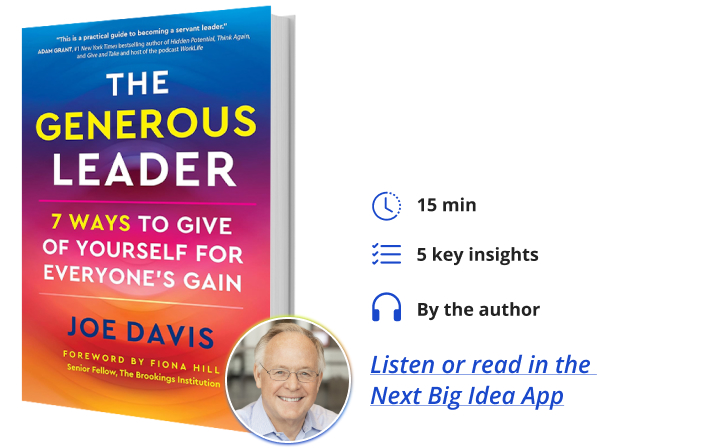Joe Davis is a Managing Director and Senior Partner at the Boston Consulting Group. He is a former Head of BCG in North America and a member of the firm’s Executive Committee. He oversaw BCG’s operations in the US, Canada, and Mexico and was recognized as one of the Top 25 Consultants of the Year in 2011.
Below, Joe shares five key insights from his new book, The Generous Leader: 7 Ways to Give of Yourself for Everyone’s Gain. Listen to the audio version—read by Joe himself—in the Next Big Idea App.

1. Now is the time for generous leaders.
A generous leader gives freely, without expectation of direct personal benefit, but to help others develop, grow, and thrive. The days of command-and-control leaders are over. Today, our work and life worlds have become very intermingled, which has led to different expectations in the work environment. People are more uncertain and look to their leaders to be there for them, lead the organization with purpose, and lead with exemplary values.
The work-life blur has been driven by technology and the pandemic. Since Blackberry in 1999, our phones have been on 24 hours. The personal computer, Zoom, and other technological advances have meant that work can be with you 24/7 if you let it. If you add to this the work-from-home pandemic, our home and work lives have become one.
On top of this, we live in disconcerting times. There have been many tough moments over the last 50 years or so, but one could argue we have not seen so many at the same time. We’ve experienced COVID, the January attack on the Capitol, Russia’s invasion of Ukraine, the Hamas-Israel conflict, climate change, the fight for social equity, and intense US elections. These events are all intensified by social media, which is in your face at nearly every moment. New information comes at you immediately if you glance down at your phone. With the changing workforce and the stress and anxiety of these times—all amplified by technology—the time for the heart to play a bigger role in any leader’s leadership is now!
2. The definition of a tough leader is changing.
We used to say tough times require a tough leader, but the definition of a tough leader is changing. Employees are demanding more considerate leaders who are there for all stakeholders, not just shareholders and investors. The definition of a tough leader now is a leader who is willing to make decisions, stand up for all stakeholders, and be empathetic. In fact, this is demanded of leaders now.
Kristen Peck, CEO of Zoetis, the pet pharmaceutical company, told Alan Murray, CEO of Fortune, that millennials, representing 50 percent of today’s workforce, want to work for organizations where leadership shares their values. They want leaders who are more empathetic, engage with them, communicate with them differently, and who are tough enough to be vulnerable and authentic. For them, this is what builds trust.
“Generous leaders must be able to connect personally and deeply with others.”
Fran Katsoudas, EVP and Chief People, Policy and Purpose Officer at Cisco, shared that a leader pulled her aside and told her she didn’t have enough killer instinct. She was warned that she would do better if she simply didn’t care enough. Luckily, she didn’t follow that advice as it wasn’t authentic to her. That advice didn’t work out for that leader either, and she believes it will not work well for today’s leaders. Instead, she prefers to make tough decisions, engage in intense issues, push to move fast, but will always strive to do so respectfully and with care. Leaders must be highly effective managers, with exceptional core business skills. But they must also bring their hearts front and center into their leadership: they must be generous.
So what makes a generous leader? There are seven key traits. Generous leaders must be able to connect personally and deeply with others. They also need to be a generous listener, listening to learn. These leaders need to be welcoming and inclusive of everyone, being a generous ally while helping others perform at their best. They have to learn others’ strengths and know their opportunities for development. They must keep their eye out for opportunities to do small acts that have a big impact. Finally, they must be authentic and vulnerable.
3. Generous listening is critical.
This isn’t just listening but really hearing someone, working to understand where they are coming from, why they think what they think, and striving to learn what you don’t know. The emphasis is on asking questions.
Tom Monihan, CEO of Heidrick and Struggles, stated that the answer is rarely obvious when making big decisions. You never have the entire picture and therefore must always ask a lot of questions. Google did a study called Project Oxygen where they interviewed 80,000 managers. What was common amongst the best? They were good coaches; they engaged and empowered employees by asking questions and listening to the answers.
If you do this, you are showing respect, and you are telling the person you see them as a human rather than a cog in the org wheel. It also helps you to solve challenges more effectively and move your organization forward productively. Scott Kirby, the CEO of United Airlines, shared a great story about asking questions and making atypical decisions. Scott is responsible for interviewing every person considered for the Vice President (VP) role. When he interviewed three new potential Operations VPs to oversee the mechanics, he asked all three, “What is the number one thing that airport technicians need?” The response was the same from each; they needed more spare parts on hand. And they’re right! Those neon-clad technicians have to board a plane when it has a problem and fix it as fast as possible. They need all the parts available at all times. Scott told me he took that information and chose to buck the conventional “spreadsheet math” and put more parts in the field. He was quite sure the morale boost to this critical team at United would outweigh the price of a bit more working capital tied up at an airport.
This is a great example of listening to learn and then taking action. To get going with this concept, consider (over) preparing for meetings, look at who is coming, what history/background they are bringing to the meeting, and how you will engage with them to learn their best insights. Always ask questions, and engage the skeptics, uncover the no’s. Your staff will know something you do not know about why an idea will not work. You want and need that information. Plus, it is even more rewarding when they reveal ideas to solve a roadblock. A generous listener asks questions and shows respect—there is so much to learn.
4. Connecting personally and deeply is expected, almost demanded.
As Kristen Peck, CEO of Zoetis, shares, “Employees expect you to connect and communicate in new ways.” Study after study showed that during the pandemic, people preferred to work for a connected leader. They had greater life satisfaction, stronger resilience and better mental health when they felt a greater connection to their leader, and they delivered a five percent higher productivity.
“Adam Grant noted that we consume 2.3 million words and numbers over a 3-month period.”
Joaquin Duato, Chairman and CEO of Johnson & Johnson, uses several techniques to achieve this connection with his staff. Firstly, he uses a concept called group testings; before speaking to a large group of employees, he will gather a small group of employees to test his talk. He will do the talk and then ask the listeners what they heard, write down the words they heard, and if they weren’t actually the words he used, he changes those words in the larger presentation as those are the words that connected with them. Secondly, he asks someone to tell him what he said, as if they were telling their family at dinner that night. He then incorporates those insights into his talk.
There are other techniques you can use to try to connect more with your staff:
- First, it’s vitally important to see the person, not the role, and to recognise them for being just that.
- Second, you can create your own sounding board, as Joaquin does, and trim the word count in your messaging. The University of Maryland reported we focus for 26 seconds on something we are reading or hearing. Adam Grant noted that we consume 2.3 million words and numbers over a 3-month period.
- Third, you should harness technology by being aware of the tools your team uses, and use them.
- Fourth, you should apply the once, twice, three times rule. The first time you make a point, the listener hears the words but is not engaged in what you are saying, as they are thinking, “Where is this going?” The second time their mind has wandered, they do not even hear you. The third time they engage. People want to hear from you. They want you to connect. They want to know you know they are human, and they want to see that you are human.
5. People expect their leaders to take off the mask.
Employees now expect their leaders to be vulnerable, authentic, and honest. As a leader, when you demonstrate vulnerability and are honest, you free others. You free people to expose their roadblocks and their fears; they feel more empowered; and their performance improves. This is a hard thing to do, to cross the line to a more vulnerable place, to admit you don’t have all the answers. As a leader, it is hard but important. If a team always turns to their leader for the answers, they don’t have an opportunity to look for the answers themselves, to grow, to find a way out of a problem.
It can be hard to show vulnerability; however, there are ways you can achieve it. By releasing your own fears and by watching others, you can learn to embrace your vulnerability. Christine Sistrunk, CEO of Ares Energy, has shared that she likes to carefully observe and watch other leaders when she sees them sharing a moment of honesty and vulnerability. She likes to see how they handled it, how others reacted to it, and how she can use their technique herself. So, experiment, take a small chance, and share a bit more about yourself with your team than you may have done in the past. Try saying, “I don’t know,” and then let your team find the answer.
Bringing more of the authentic you into your work life is now an essential element of exceptional leadership. You have little choice because others expect it; but in doing it, you may just free others to bring their full self as well. Today, people in the workforce are expecting a generous leader. More importantly, when you live the traits of a generous leader, with true care and integrity, you will send a ripple of positive change across our society.
To listen to the audio version read by author Joe Davis, download the Next Big Idea App today:































